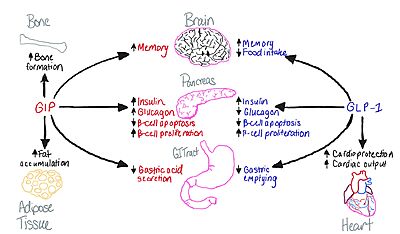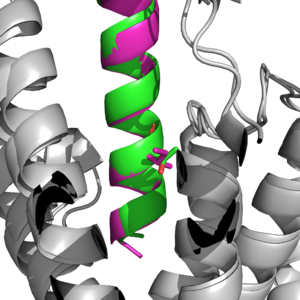Introduction
The Glucose-dependent Insulinotropic Polypeptide (GIP) is a ligand that can be bound to its receptor (GIP-R) to help facilitate the breakdown of glucose. This is the basis of what makes up one of the key ways that glucose is bound and broken down into different parts, including insulin, to be able to maintain blood glucose levels within the body. With this structure, it is also to work with the GLP-1 receptors found within cells to help break down glucose present within cells to create energy. Unfortunately for many people with diabetes, they are unable to bring in as much glucose from the GLUT-1 transporter found within a cell and causes a higher blood glucose level that can become toxic if left untreated [1].

Figure 1: Distinction of functions between the GIP and GLP-1 receptors.
History
The main receptor, originally named Gastric Inhibiory Polypeptide, was found in 1902 and shown to have impacts on secretory pathways present within the cell. It wasn't until 1984, when the receptor was found and have many of the functions it has today. This is able to play into discovering the Type 2 Diabetes medication, Mounjaro (tirzepatide),
Function
The GIP receptor helps facilitate movement of glucose within a cell. [2]. It has a natural ligand that is 42 residues and helps kickstart the GIP-R into firing, as a transporter for glucose in and out of the cell. Once the levels become too high, the ligand will send this transporter back down into the cell and not have anymore glucose activate. It will also cause the insulin pathway to start to help signal that there is too much glucose in the body. As mentioned above, many issues that arise with diabetes can affect the rate of transport within these transporters for the cell.
Tirzepatide
Tirzepatide has been used as a treatment for Type 2 diabetes and It is used to help treat Type 2 Diabetes, as an agonist to allow insulin to be broken down. This also works in tandem with GLP-1, as mentioned within Figure 1 earlier on. It also contains two residues with an AIB sequence, which stands for alpha-amino isobutric acid and aids with preventing degradation of the peptide [3]. This sequence is part of the reason as to why part of the molecule is broken to help absorb more of the interaction that is present throughout the part of the cell and cause an increased rate of transport of glucose into the different cells.
Structural Highlights
Tirzepatide and the natural GIP for the receptor contain some key differences, but they are all able to bind with a strong affinity to the receptor. Some of the different molecules could be useful into explaining why a tirzepatide molecule is able to bind at a stronger affinty for the receptor than the ligand that will bind and cause a cascade to start a signaling pathway for more binding.
Active Site
Main binding domains between tirzepatide and the GIP receptor would contain an arginine 190 and glutamine 220 residues to facilitate binding of the ligand. The binding is also able to use a tyrosine residue at position 1 that helps guide the ligand into the correct binding spot [2].One key difference found was a point mutation at position 7 between an Isoleucine and Threonine [2], which would result in a higher affinity for the tirzepatide molecule binding onto the receptor than the ligand. Due to the change of a nonpolar residue turning to a polar with the ability to hydrogen bond onto the R190 and Q220, making it a stronger site for binding. With this higher binding affinity, the ligand of tirzepatide is able to interact with the transporter and add in glucose to the cell.

Figure 2: Key difference between GIP ligand and Tirzepatide at position 7. Ile7 is in pink (ligand), and Thr7 is in aqua(tirzepatide).
References
- ↑ Seino Y, Fukushima M, Yabe D. GIP and GLP-1, the two incretin hormones: Similarities and differences. J Diabetes Investig. 2010 Apr 22;1(1-2):8-23. PMID:24843404 doi:10.1111/j.2040-1124.2010.00022.x
- ↑ 2.0 2.1 2.2 Sun B, Willard FS, Feng D, Alsina-Fernandez J, Chen Q, Vieth M, Ho JD, Showalter AD, Stutsman C, Ding L, Suter TM, Dunbar JD, Carpenter JW, Mohammed FA, Aihara E, Brown RA, Bueno AB, Emmerson PJ, Moyers JS, Kobilka TS, Coghlan MP, Kobilka BK, Sloop KW. Structural determinants of dual incretin receptor agonism by tirzepatide. Proc Natl Acad Sci U S A. 2022 Mar 29;119(13):e2116506119. PMID:35333651 doi:10.1073/pnas.2116506119
- ↑ Chavda VP, Ajabiya J, Teli D, Bojarska J, Apostolopoulos V. Tirzepatide, a New Era of Dual-Targeted Treatment for Diabetes and Obesity: A Mini-Review. Molecules. 2022 Jul 5;27(13):4315. PMID:35807558 doi:10.3390/molecules27134315
Student Contributors
SaraKathryn Kalkhoff
Camille Gaudet


